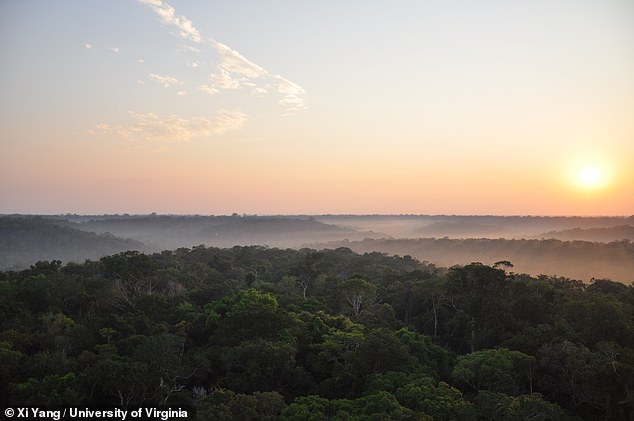Some Amazon rainforest regions are more resistant to climate change than previously thought and could actually BENEFIT from warmer temperatures, study finds
- Researchers studied how changes in soil and air moisture affect photosynthesis
- It had been thought that water stress would have a broadly negative impact
- This, in turn, would slow carbon uptake by the Amazon and increase warming
- However, in wetter areas, dry air causes plants to grow more efficient leaves
- The team warned, though, that excessive warming would also harm these areas
Warmer temperatures may benefit parts of the Amazon rainforest, suggesting that the tropical ecosystem may be more resistant to climate change than once thought.
It had previously been thought that water stress brought on by global warming and the drying out of the soil and air would broadly harm the plants of the Amazon.
This would lead to reduced photosynthesis — the chemical process by which plants make food and absorb in carbon dioxide — and help accelerate climate change.
However, US researchers found that wetter areas of the world’s largest rainforest actually grow leaves more efficient at photosynthesis when exposed to dry air.
The team warned that there is a limit to this, however, and that excessively warm temperatures would still cause damage to even these resilient parts of the forest.
Warmer temperatures may benefit parts of the Amazon rainforest, pictured, suggesting that the tropical ecosystem may be more resistant to climate change than once thought
‘This is the first basin-wide study to demonstrate how, contrary to what models are showing, photosynthesis is in fact increasing in some of the very wet regions of the Amazon rainforest during limited water stress, said paper author Pierre Gentine.
‘This increase is linked to atmospheric dryness in addition to radiation and can be largely explained by changes in the photosynthetic capacity of the canopy,’ added the environmental scientist from Columbia University in the United States.
‘As the trees become stressed, they generate more efficient leaves that can more than compensate for water stress.’
In their study, Dr Gentine and colleagues used machine learning techniques to analyse data from various climate models to determine how changes in air dryness and soil moisture across the tropical regions of the Americas affects photosynthesis.
The compared these analyses with those made of observational remote sensing data collected from satellites passing over the rainforests.
Data from so-called flux towers — which monitor carbon dioxide exchange rates between the earth and the atmosphere around the globe — were then used to study processes on the smaller scales.
The greenness of plants in parts of the Amazon basin at the end of the dry season had been observed in previous research.
‘Before our study, it was still unclear whether these results translated to an effect over a larger region — and they had never been connected to air dryness in addition to light,’ added paper author Julia Green.
‘Our results mean that the current models are overestimating carbon losses in the Amazon rainforest due to climate change.’
‘In this particular region, these forests may in fact be able to sustain photosynthesis rates, or even increase it, with some warming and drying in the future.’
However, the team warned, if the dryness to increase beyond the observed levels, photosynthesis could still slow down in the future.
‘We found a tipping point for the most severe dryness stress episodes where the forest could not maintain its level of photosynthesis,’ said Dr Green.
‘So our findings are certainly not an excuse to not reduce our carbon emissions.’
With their initial study complete, the researchers are now looking to measure the impacts of water stress on the carbon dioxide intake of plants — and relating this to specific ecosystem traits.
‘So much of the scientific research coming out these days is that with climate change, our current ecosystems might not be able to survive, potentially leading to the acceleration of global warming due to feedbacks,’ Dr Green mused.
‘It was nice to see that maybe some of our estimates of approaching mortality in the Amazon rainforest may not be quite as dire as we previously thought.’
The full findings of the study were published in the journal Science Advances.

